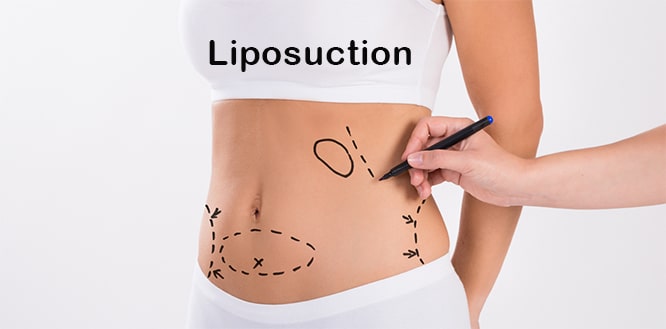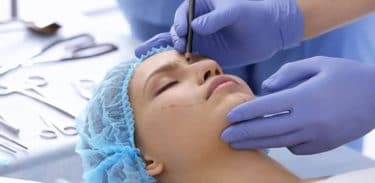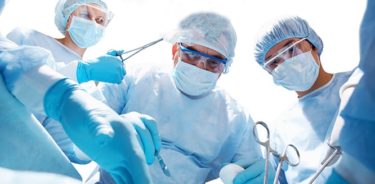Liposuction is a surgical procedure that breaks down fat accumulation in body’s diet and exercise resistant areas and removes it from body. In other words, it is a fat extraction operation with a vacuum technique for certain parts of the body. It is usually applied to abdomen, buttocks, thighs, arms and neck. Liposuction improves specific areas of body by removing excess fat deposits and reshaping lines. It is done under general or local anesthesia. If a person is suitable for this surgical procedure and he or she complies with doctor’s instructions given, it is a smooth operation. However, complications, such as excessive bleeding, which can occur in every surgery, can have dangerous consequences. For this reason, liposuction should not be rushed, and as with any surgical intervention, it should be embarked upon only after a thorough investigation of all the ins and outs.
Table of Contents
What is Liposuction?
Liposuction is a surgical procedure in which regional fat deposits are withdrawn by vacuum technique or with a special syringe. It can be performed together with this surgery so shapes the body contours or lines. Different liposuction techniques have been developed with the advance of medical technology. Liposuction is favored by women mostly because of aesthetic concerns. However, it can also be applied to men for medical reasons.
Differences between body sculpting, body contouring and liposculpturing
The common feature of these three is that they only aim to shape the body. The differences are:
- Body sculpting: It aims to shape the body through exercises like fitness, diet, etc.
- Body contouring: It is the surgery that reshapes the body contours after slimming.
- Liposculpturing: In this procedure which is based on liposuction, fat tissue in the body is removed by vacuum and transferred to the necessary areas in order to reshape the lines.
Why is liposuction done?
Liposuction is usually done to get rid of the stubborn fats accumulated in some areas due to various reasons like genetics, unbalanced nutrition, pregnancy and so on. It can also be used in the treatment of certain disorders such as lipoedema (painful lubrication syndrome) and gynecomastia (abnormal breast growth in men).
Liposuction (fat removal) and weight loss
Liposuction reduces the amount of fat cells in specific regions. The amount of fat removed depends on the appearance of the area and the volume of the fat. The resulting contour changes are usually permanent as long as your weight remains constant. However, liposuction is not a weight loss method.
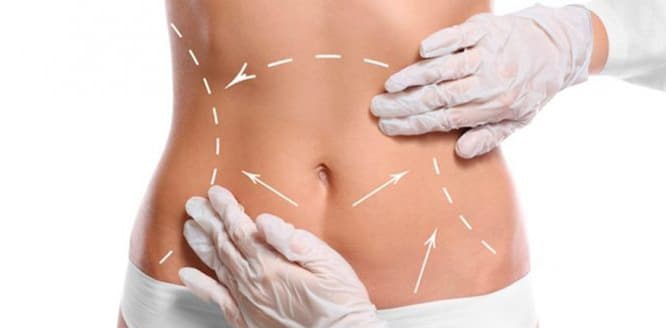
Most people have recourse to liposuction for aesthetic reasons; but it is not done for obesity or excess weight that can be gotten rid of with a proper exercise and diet. It also does not improve skin surface irregularities such as cellulitis or drooping skin; and does not remove the cracks. It is not a skin stretching surgery. It only removes fat in a particular region and shapes body.
Liposuction is used for whom?
Liposuction is done to healthy, non-smoking individuals who are close to their healthy weight (30% of the ideal weight) and have a firm-elastic skin; but have stubborn fat deposits under their skin that do not contain visceral fat (a kind of dangerous body fat that is formed in the abdominal cavity and can surround the vital organs).
In this process, skin structure is important because in people with sagging, loose skin or cellulite, this process can cause problems such as rotten skin and so on.
On the other hand, in those with a good skin tone and elasticity, the skin may appear smooth after the procedure. For this reason, liposuction is more successful in people who have a relatively tight skin and normal weight. The results are longer lasting and can help to maintain a healthy weight.
How is liposuction performed?
- Before surgery, the surgeon marks the area from which the fat will be removed. In addition, photographs can be taken to compare the before and after surgery.
- After anesthesia, a sterile liquid solution is injected into the area to be treated. This liquid contains lidocaine (anesthetic med.) for relieving pain in the area, epinephrine (adrenaline) for preventing bleeding by narrowing blood vessels, physiological serum (saline) and bicarbonate,. This liquid solution numbs and stiffens the skin.
- A small incision is then applied on the skin and a cannula attached to the vacuum machine is inserted in this incision. As the vacuum tube is moved back and forth, fat is broken down and suctioned out. Excess fluid and blood are also discharged.
- The wounds may be left open to drain excessive fluid (and preventing edema development) after surgery.
- After the process is finished, area is stitched up and wrapped tightly with the bandage.
If general anesthesia is applied in a liposuction operation or if a large amount of fat is taken at a time, staying overnight in the hospital to prevent complications is usually recommended. In case of the procedure being done under local anesthesia, you can return home a few hours after surgery.
Liposuction types and techniques
Tumescent liposuction
Before the operation, fluid is injected into the relevant area; the cannula (a thin tube) attached to vacuum machine or the syringe to remove the fat is then inserted into the small incision in the respective area.
After that, the machine breaks down and suctions out the fat from the relevant area. Unless general anesthesia is performed, the person is usually not hospitalized.
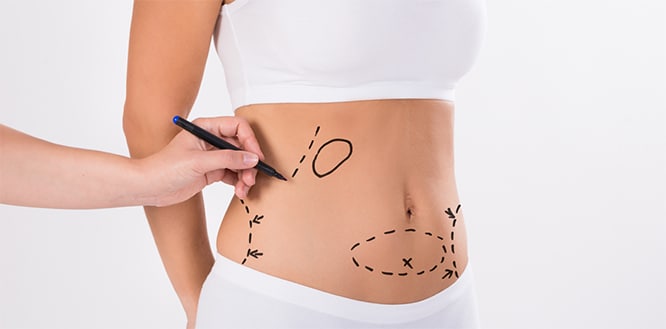
Laser-assisted liposuction (LAL)
This method uses laser energy (light waves) at a specific wavelength to soften the fat after the liquid has been injected into the area. The laser energy, which makes fat viscous by crushing it, is applied by making small cuts in the relevant area and then placing the cannula attached to the fiber laser cable.
After the fat removal procedure, another wavelength can be used to tighten the skin. After the surgery, rashes, bruising and swelling may develop depending on the skin sensitivity.
Advantages of Laser-assisted liposuction
- It ensures more controlled fat removal.
- It prevents bleeding.
- It may not require stitching.
- It provides improvement in a short time.
- Time required to keep a bandage or corset is shortened after procedure.
- Since it is usually performed under local anesthesia, an overnight hospital stay is not required.
Ultrasound-assisted (vaser) liposuction
In this technique of liposuction, the concerned area is first marked, then a liquid solution that stiffens the skin is injected here. After, a cannula attached to a metal probe that emits ultrasonic waves under the skin is inserted. In this way, the fat cell walls are broken down, and it becomes easier to remove the liquefied fat.
Advantages of ultrasound-assisted (vaser) liposuction
- It can be applied to larger areas, and different fat layers at the superficial, medium and/or deeper level.
- There is less likelihood of fluctuation and collapse.
- The loosened skin after the procedure is more easily recovered.
- It can be effective in forming a more smooth body line.
- Usually, local anesthesia is applied to the patient. However, general anesthesia is preferred if more than one area is to be treated. Unless general anesthesia is performed, the patient may be discharged from the hospital a few hours later.
Disadvantages of ultrasound-assisted (vaser) liposuction
- Although fat removal procedure is successful, skin tightening is not observed.
- Ultrasound may cause burns on the surface of the skin and/or deeper tissues.
After liposuction surgery
Recovery after liposuction surgery and postoperative care may vary depending on the treated area and the amount of fat removed. But usually the person can return to work in a few days, all normal activities such as exercise can be resumed after 2-4 weeks or less.
Complying with the doctor’s recommendations (no smoking, no alcohol, plenty of resting, etc.) provides a shorter and smoother recovery. Antibiotics and painkillers can be prescribed to prevent the risk of infection.
Seeing the results of liposuction usually takes time, from 4-5 weeks to 6 months depending on the procedure. The positive outcome of this process will usually last longer if you maintain your ideal weight. It should be noted that liposuction does not prevent weight gain. If you gain weight after the procedure, your fat distribution may change and new fat deposits may develop in any part of your body (or in the same area).
Therefore, liposuction surgery should be supported by a healthy lifestyle that includes exercises and a healthy diet consisting of lean protein, fruits, vegetables, whole grains and low-fat milk.
There may be some discomfort in the healing process. These include but are not limited to:
- Bruising and swelling for about 6 months
- Drowsiness for 6 to 8 weeks
- Scars
- Inflammation of the vessels of the treated area or underneath of it.
- Fluid draining from wounds due to incision.
- Swollen ankles or legs, if the legs or ankles are treated.
To minimize these side-effects and reduce bruising and swelling, the treated area is wrapped with a bandage or support braces are used. It should be used continuously for several weeks after surgery.
How much fat is removed at a time in liposuction surgery?
It may vary depending on health and aesthetic ideals of person. The specified daily limit is 2.5 to 4.5 liters per day. However, there may be surgeons who can remove more fat a day.
How long does a liposuction surgery take?
The time may vary depending on the area treated and the amount of fat removed, but it usually takes between 1 to 3 hours.
Is liposuction surgery safe?
Liposuction surgery is not a dangerous operation under normal conditions. Plastic surgeons note down all the information they need to learn from the patient before the surgery. Surgery is prepared in line with this information. However, it can carry risks such as allergic reaction to anesthesia or excessive bleeding as mentioned before. In addition, a serious skin infection can be life-threatening.
Risks of liposuction surgery
If the liposuction procedure is not done by an experienced doctor, possibility of risks may increase and some complications may occur after surgery:
- Uneven contours: Your skin may appear uneven, wavy or faded due to excessive fat removal, poor skin elasticity, and unusual healing. These changes may be permanent. Subcutaneous damage caused by which the thin cannula used during liposuction can create a permanent stained appearance on the skin.
- Blood accumulation: Temporal seroma looking like a tumor under the skin (swelling with a full blood inside) may occur. This blood may need to be drained with a needle.
- Numbness: You may feel temporary or permanent numbness in the affected area. Temporary nerve irritation is also possible.
- Infection: Skin infections and inflammation are rare, but possible.
- Organ damage: Rarely, a deep penetrating cannula can penetrate one of the internal organs and require urgent surgical intervention.
- Fat embolism: Loosened fat particles can be broken down, trapped in a blood vessel and accumulated in the lungs or moved to the brain. It requires urgent intervention.
- Kidney and heart problems: A change in fluid level that may develop when fluid is drawn out of the affected area can lead to kidney and heart problems, and this can pose a potential danger.
- Slow recovery: The healing process of the patient is longer than expected.
- Hematite: Blood accumulation under uninjured skin.
- Pulmonary edema: Fluid accumulation in the lungs due to fluid injected into the body.
- Pulmonary emboli: Sudden blockage of the pulmonary artery.
- Dehydration: Problems which may cause shock such as excessive fluid loss can be seen.
Does liposuction lead to scarring?
Liposuction surgery can cause scarring due to cuts or holes opened with cannulas. Because these tools are thin, scarring is minor. The number of scars may vary depending on the number of cannula insertions. Persistence depends on skin type and quality.
Liposuction body parts
- External thighs (rarely inner thighs)
- Hips and buttocks
- Abdominal area (fats over the belly)
- Waist area, especially side parts
- Upper-lower arms
- Back (rarely upper back)
- Inner knee region
- Especially the bra strapping area of the chest
- Male breasts
- Double chin formation
- Back of the neck
- Lower leg and/or ankles
- Cheeks
Liposuction can be used alone or in combination with other plastic surgeries, such as face lift, breast reduction or tummy tuck.
Liposuction for women
Liposuction can be done in almost all parts of the body with fat accumulation in women. In addition, it can be used as a treatment method in conditions such as lipoma (fatty lump in the underlying muscle layer of the skin), lipoedema (painful regional lipoidosis), lymph edema (a chronic condition that causes swelling in the tissues of the body), lipoedema (chronic fatty cells accumulation in certain regions such as hip).
Although liposuction is also performed for cellulite treatment, it does not remove cellulite and even sometimes makes it look worse. Laser assisted liposuction can be applied depending on some cellulite types, but the results are not satisfying yet.
Liposuction for men
It can also be carried out on all areas of the male bodies, but it is usually performed in the case of enlarged breasts (gynecomastia), lymph edema and lipomas. Nowadays, even if men want to remove regional fat for aesthetic purposes, this surgery is not recommended because the procedure doesn’t go along with their skin-fat-muscle structures. Perhaps this problem can be solved by medical technology advances.
Which doctor should you go for liposuction?
It is ideal to go to a licensed and experienced aesthetic surgeon, but an experienced general surgeon can also be a good choice.
Who can’t benefit from liposuction?
People who have health problems related to blood flow, heart disease, diabetes or poor immune system cannot undergo liposuction.
The cost of liposuction 2019
Prices of the liposuction operation may vary depending on the amount of fat to be taken, the number of areas to be treated, age and weight of the patient, type of anesthesia, whether there will be a need for an additional treatment, and the clinic/hospital where the treatment will be carried out. The average price in 2019 is between 800 and 5700 dolar. This price usually includes fees of surgeon, anesthesiologist, hospital and medicines.
Liposuction surgery performed in state hospitals can be covered by insurance. You can discuss your advantages with a plastic surgeon and health care provider. You can also get a comprehensive information from social security health institutions. Private health insurance generally does not cover liposuction costs, but there may be insurance agents who can pay for certain medical conditions; investigate well.
Recommendations for liposuction
- If you want to have liposuction performed because of aesthetic concerns, think well because liposuction is a costly and risky procedure.
- Choose an experienced surgeon and a reliable health facility for surgery.
- Prepare a list of questions about topics such as your goals, your treatment options, your risks, success rate, costs, etc.
- Follow all your doctor’s instructions before and after the surgery.
- Arrange someone who will get you from the hospital because you cannot drive and your drowsiness may persist after surgery.
- Find someone to take care of you, as you might need to rest in bed for a few days.
- Collapses may occur in areas where excessive fat is removed, so avoid unnecessary liposuction. For more:>>> Liposuction

